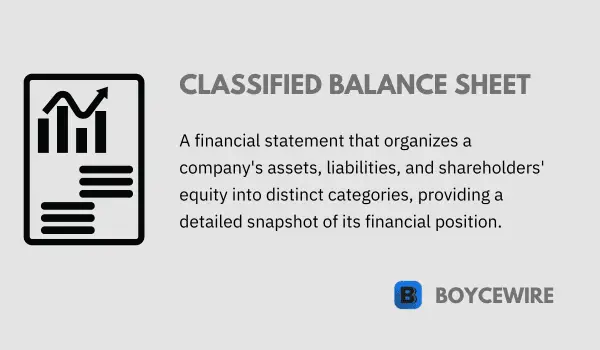Classified Balance Sheet: Definition, Components & Examples

What is a Classified Balance Sheet?
Financial management and reporting form the backbone of any successful business, providing insights into the financial health and stability of the organization. One such crucial financial statement is the classified balance sheet. Offering a snapshot of a company’s financial status at a particular point in time, a classified balance sheet serves as a key reference point for stakeholders to understand the business’s asset utilization, debt management, and equity distribution.
This type of balance sheet segregates the assets, liabilities, and equity into classifications or categories, thus presenting a more detailed and clear picture of a company’s financial condition. This in-depth information is pivotal in driving investment decisions, strategic planning, and performance evaluation.
Key Points
- A classified balance sheet categorizes assets, liabilities, and equity into current and non-current sections.
- Current assets include cash, accounts receivable, and inventory, while non-current assets include long-term investments and property.
- Current liabilities encompass short-term obligations such as accounts payable and accrued expenses, while non-current liabilities consist of long-term debt.
Understanding the Classified Balance Sheet
At its core, a classified balance sheet is an enhanced version of a standard balance sheet, with a deeper level of organization and clarity. It groups or ‘classifies’ assets, liabilities, and equity into several subcategories, making it easier for stakeholders to analyze and interpret the data.
These classifications mainly include current and non-current sections for both assets and liabilities. Current assets, such as cash, accounts receivable, and inventory, are resources expected to be used or converted into cash within a year. Non-current assets, including property, plant, and equipment (PP&E), and long-term investments, are anticipated to provide economic benefit beyond a single operating cycle or one year.
Similarly, liabilities are categorized into current and non-current or long-term liabilities. Current liabilities include obligations expected to be settled within a year, such as accounts payable and accrued expenses. Long-term liabilities, like long-term debt or lease obligations, are due beyond a year.
The equity section represents the owners’ interest in the business and typically includes common stock, retained earnings, and treasury stock.
Understanding these classifications and their importance in a balance sheet is vital for gauging the financial health of a business, assessing liquidity and solvency, and aiding efficient financial decision-making.
Components of a Classified Balance Sheet
A classified balance sheet is typically composed of the following major sections, each of which is classified further into more detailed categories:
Assets
Assets are resources owned by a company and are divided into:- Current Assets These are assets that can be converted into cash or are expected to be used up within one year or one operating cycle, whichever is longer. Current assets usually include cash, accounts receivable, inventory, and prepaid expenses.
- Non-current Assets These are long-term assets that are not expected to be converted into cash or used up within one year or one operating cycle. Non-current assets often include long-term investments, property, plant and equipment (PP&E), intangible assets (such as patents and trademarks), and deferred tax assets.
Liabilities
Liabilities represent what a company owes and are divided into:- Current Liabilities These are obligations that need to be paid within one year or one operating cycle. Current liabilities often include accounts payable, accrued expenses, short-term loans, and current portion of long-term debt.
- Non-current Liabilities Also known as long-term liabilities, these are obligations that are due after one year or one operating cycle. They often include long-term loans, bonds payable, deferred tax liabilities, and lease obligations.
Equity
Also known as shareholders’ equity or owners’ equity, this section represents the residual interest in the assets of the entity after deducting liabilities. It includes:- Capital Stock This includes common stock and preferred stock, representing the initial capital invested by the shareholders.
- Retained Earnings This represents the accumulated profits retained in the business after dividends are paid out to shareholders.
- Treasury Stock This is the portion of shares that a company keeps in its own treasury. These are the shares that have been issued but are not outstanding.
Each of these components provides valuable information about the company’s financial position, and understanding them is key to interpreting a classified balance sheet effectively.
Preparing a Classified Balance Sheet
Preparing a classified balance sheet involves organizing the assets, liabilities, and equity of a business into their respective categories. Here are the steps usually involved:
- List Current Assets Begin the balance sheet by listing the company’s current assets in order of liquidity, starting with cash. Other current assets may include accounts receivable, inventory, and prepaid expenses.
- List Non-Current Assets After listing all the current assets, move on to the non-current or long-term assets. These usually include property, plant and equipment, long-term investments, and intangible assets.
- Calculate Total Assets Once you have listed all the current and non-current assets, calculate the total assets by adding up all the individual asset amounts.
- List Current Liabilities Similar to assets, begin the liabilities section by listing the current liabilities. This typically includes accounts payable, accrued expenses, and the current portion of long-term debt.
- List Non-Current Liabilities After listing all current liabilities, proceed to the non-current or long-term liabilities. These may include long-term debt, deferred tax liabilities, and lease obligations.
- Calculate Total Liabilities Add up all the current and non-current liabilities to calculate the total liabilities.
- List Equity In the equity section, list the amounts for common stock, retained earnings, and treasury stock. If there’s preferred stock, it should be listed here as well.
- Calculate Total Equity Add up all the components of equity to calculate the total equity.
- Check Balance The final step is to verify that the balance sheet is indeed in balance. The total assets should equal the sum of total liabilities and total equity.
By following these steps, a business can prepare a classified balance sheet that provides a clear and organized snapshot of its financial position at a particular point in time. This detailed view can then be used to analyze the business’s liquidity, solvency, and overall financial health.
Benefits of a Classified Balance Sheet
A classified balance sheet is a vital tool for companies, investors, and creditors for various reasons:
- Better Financial Understanding A classified balance sheet provides a detailed breakdown of the financial position of a company. It separates assets and liabilities into current and non-current categories, helping to understand the company’s short-term and long-term financial situation.
- Improved Decision Making By understanding the distribution of a company’s assets and liabilities, management can make more informed decisions about future operations, including potential investments or the need to secure financing.
- Liquidity Analysis A classified balance sheet allows for easy assessment of a company’s liquidity by looking at the ratio of current assets to current liabilities. This can indicate whether a company has sufficient short-term assets to cover its short-term debts.
- Long-term Solvency Analysis By separating long-term assets and liabilities, a classified balance sheet can also help assess a company’s long-term solvency and its ability to meet long-term financial obligations.
- Investor Insights Investors can use this balance sheet to gain insights into a company’s financial health and stability. They can use this information to help decide whether to buy, hold, or sell a company’s stock.
- Creditors Insights Creditors can use a classified balance sheet to assess a company’s ability to repay its debts. The distribution of current and non-current assets and liabilities can provide valuable information about a company’s credit risk.
In summary, the detailed and structured presentation of assets, liabilities, and equity in a classified balance sheet enables more comprehensive financial analysis and more informed decision-making for all stakeholders.
Limitations of a Classified Balance Sheet
While a classified balance sheet provides many advantages, it also has certain limitations:
- Lack of Real-Time Information The balance sheet is a snapshot of a company’s financial position at a specific point in time. However, financial conditions can change rapidly, and the balance sheet may not reflect recent events or transactions.
- Subjectivity in Classifications Although guidelines exist, there can still be subjectivity in determining whether an item is current or non-current. Different organizations may classify items differently, which could lead to difficulties when comparing companies.
- Historical Cost Basis Assets are generally recorded at their original cost, which may not represent their current market value. For example, property or equipment might appreciate or depreciate over time, but these changes are not reflected in the balance sheet.
- Non-Monetary Assets and Liabilities Some items that could significantly impact a company’s financial health, such as brand reputation or intellectual property, are not easily quantifiable and therefore are not included on the balance sheet. Similarly, potential liabilities like pending lawsuits may also be left off the balance sheet.
- Influence of Accounting Practices Certain accounting practices, like revenue recognition or inventory costing methods, can influence the presentation of the balance sheet. This could potentially distort the understanding of a company’s financial position.
- Lack of Operational Insight While a balance sheet provides valuable data about a company’s financial position, it doesn’t give detailed insights into a company’s day-to-day operations or market conditions, which can also be critical in assessing a company’s health and performance.
It’s important for users of a classified balance sheet to be aware of these limitations and to use the balance sheet as just one tool in their overall analysis of a company’s financial health.
Examples of a Classified Balance Sheet
Here are a few simplified examples to illustrate how a classified balance sheet might look for different types of businesses:
Example 1: Small Retail Business
- Assets:
- Current Assets:
- Cash: $10,000
- Accounts Receivable: $6,000
- Inventory: $14,000
- Non-current Assets:
- Property, Plant, and Equipment: $50,000
- Less: Accumulated Depreciation: ($10,000)
- Net Property, Plant, and Equipment: $40,000
- Current Assets:
- Liabilities and Equity:
- Current Liabilities:
- Accounts Payable: $5,000
- Accrued Expenses: $1,000
- Non-current Liabilities:
- Long-term Debt: $20,000
- Equity:
- Common Stock: $20,000
- Retained Earnings: $24,000
- Current Liabilities:
Example 2: Large Manufacturing Corporation
- Assets:
- Current Assets:
- Cash and Cash Equivalents: $200,000
- Short-term Investments: $100,000
- Accounts Receivable: $150,000
- Inventory: $300,000
- Non-current Assets:
- Property, Plant, and Equipment: $2,000,000
- Less: Accumulated Depreciation: ($500,000)
- Net Property, Plant, and Equipment: $1,500,000
- Goodwill: $250,000
- Other Intangible Assets: $200,000
- Current Assets:
- Liabilities and Equity:
- Current Liabilities:
- Accounts Payable: $100,000
- Accrued Expenses: $50,000
- Short-term Debt: $200,000
- Non-current Liabilities:
- Long-term Debt: $1,000,000
- Deferred Tax Liability: $150,000
- Equity:
- Common Stock: $500,000
- Retained Earnings: $1,000,000
- Current Liabilities:
Remember, these are highly simplified examples. Real-world classified balance sheets can be much more complex and include many more line items, especially for large corporations.
FAQs
A classified balance sheet helps organize and categorize a company’s financial information into relevant sections, providing a clearer picture of its financial position and aiding in financial analysis.
The main categories on a classified balance sheet include current assets, non-current assets, current liabilities, non-current liabilities, and shareholders’ equity.
Unlike an unclassified balance sheet, which presents all assets, liabilities, and equity together without categorization, a classified balance sheet separates these items into distinct categories, providing more detailed information.
Classifying assets and liabilities as current or non-current helps assess the company’s short-term and long-term financial health. Current items are those expected to be converted into cash or settled within one year, while non-current items are held for longer periods.
About Paul
Paul Boyce is an economics editor with over 10 years experience in the industry. Currently working as a consultant within the financial services sector, Paul is the CEO and chief editor of BoyceWire. He has written publications for FEE, the Mises Institute, and many others.

Further Reading
 Economic Growth - Economic growth is the long-term increase in an economy's capacity to produce goods and services.
Economic Growth - Economic growth is the long-term increase in an economy's capacity to produce goods and services.  Expansionary Fiscal Policy: Definition, Examples & Effects - Expansionary fiscal policy refers to a policy that seeks to grow the economy through fiscal stimulus.
Expansionary Fiscal Policy: Definition, Examples & Effects - Expansionary fiscal policy refers to a policy that seeks to grow the economy through fiscal stimulus.  Nominal Interest Rate - The nominal interest rate is the stated interest rate without accounting for inflation, representing the rate at which money grows…
Nominal Interest Rate - The nominal interest rate is the stated interest rate without accounting for inflation, representing the rate at which money grows… 